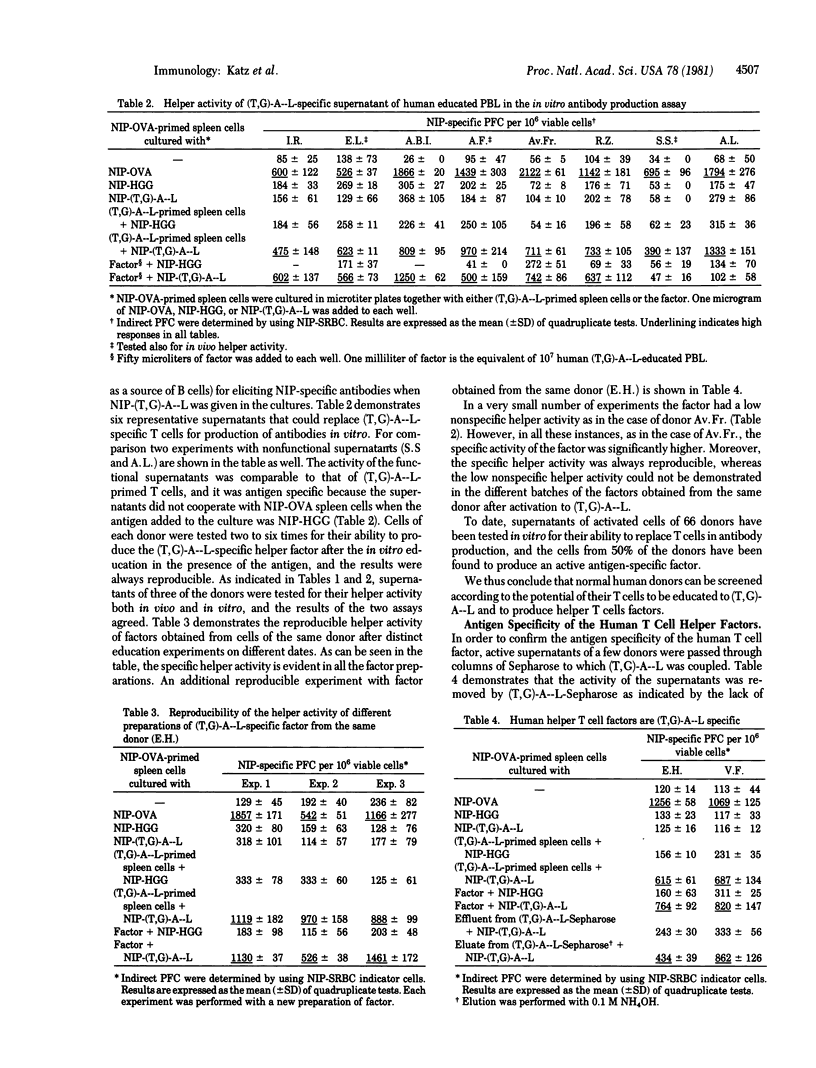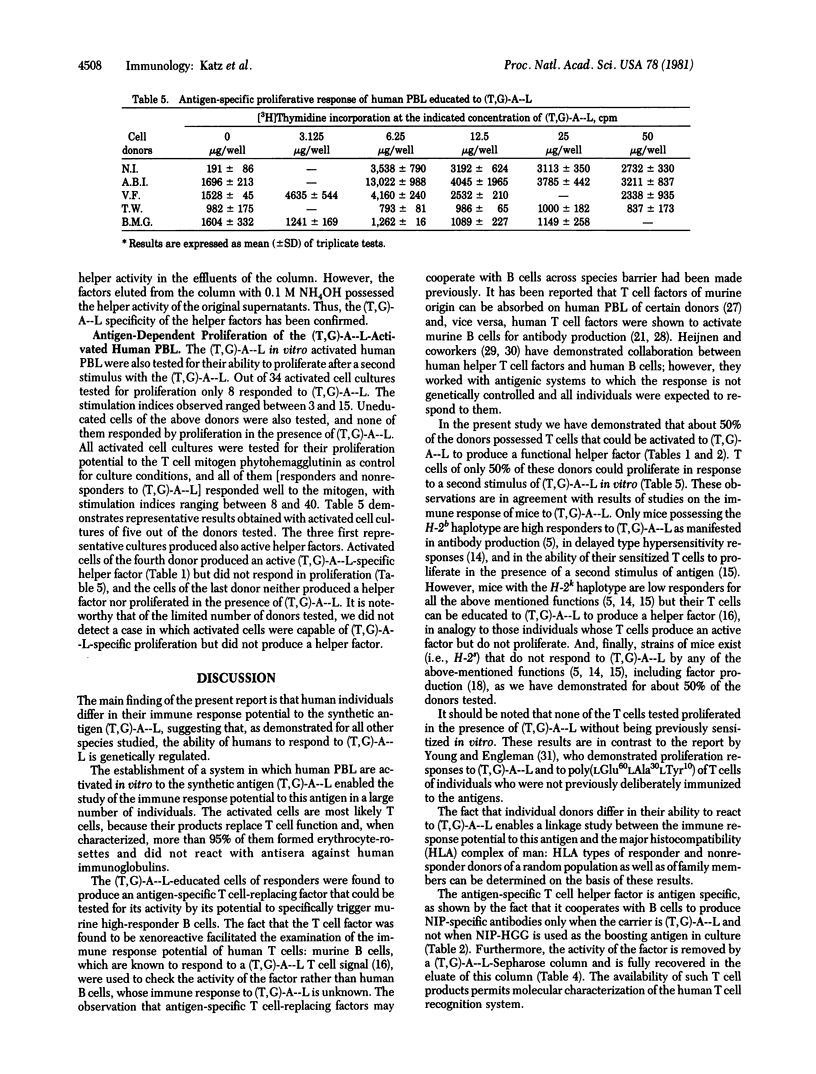Abstract
Human peripheral blood T cells of normal donors were activated in vitro with autologous adherent cells pulsed with poly(LTyr,LGlu)-poly(DLAla)--poly(LLys) [abbreviated (T,G)-A--L]. The "educated" T cells were tested: (i) for their ability to produce a (T,G)-A--L-specific T cell-replacing factor in the cooperation with B cells for antibody responses in vivo or in vitro and (ii) for their ability to proliferate in the presence of a second stimulus of (T,G)-A--L. Results of screening of 66 donors demonstrated that educated T cells of about 50% of the donors produced an active (T,G)-A--L-specific factor, whereas activated cells of only half of the factor producers were capable of proliferating in the presence of the antigen. Thus, as reported for all other species studied, human individuals differ in their response potential to (T,G)-A--L.
Full text
PDF




Selected References
These references are in PubMed. This may not be the complete list of references from this article.
- Ballieux R. E., Heijnen C. J., Uytdehaag F., Zegers B. J. Regulation of B cell activity in man: role of T cells. Immunol Rev. 1979;45:3–39. doi: 10.1111/j.1600-065x.1979.tb00271.x. [DOI] [PubMed] [Google Scholar]
- Balner H., Dorf M. E., de Groot M. L., Benacerraf B. The histocompatibility complex of rhesus monkeys. 3. Evidence for a major MLR locus and histocompatibility-linked Ir genes. Transplant Proc. 1973 Dec;5(4):1555–1560. [PubMed] [Google Scholar]
- Benacerraf B., Katz D. H. The histocompatibility-linked immune response genes. Adv Cancer Res. 1975;21:121–173. doi: 10.1016/s0065-230x(08)60972-0. [DOI] [PubMed] [Google Scholar]
- Bluestein H. G., Ellman L., Green I., Benacerraf B. Specific immune response genes of the guinea pig. 3. Linkage of the GA and GT immune response genes to histocompatibility genotypes in inbred guinea pigs. J Exp Med. 1971 Dec 1;134(6):1529–1537. doi: 10.1084/jem.134.6.1529. [DOI] [PMC free article] [PubMed] [Google Scholar]
- Cunningham A. J., Szenberg A. Further improvements in the plaque technique for detecting single antibody-forming cells. Immunology. 1968 Apr;14(4):599–600. [PMC free article] [PubMed] [Google Scholar]
- Dorf M. E., Balner H., de Groot M. L., Benacerraf B. Histocompatibility-linked immune-response genes in the rhesus monkey. Transplant Proc. 1974 Jun;6(2):119–123. [PubMed] [Google Scholar]
- Eshhar Z., Strassmann G., Waks T., Mozes E. In vitro and in vivo induction of effector T cells mediating DTH responses to a protein and a synthetic polypeptide antigen. Cell Immunol. 1979 Oct;47(2):378–389. doi: 10.1016/0008-8749(79)90347-2. [DOI] [PubMed] [Google Scholar]
- Günther E., Rüde E., Stark O. Antibody response in rats to the synthetic polypeptide (T,G)-A--L genetically linked to the major histocompatibility system. Eur J Immunol. 1972 Apr;2(2):151–155. doi: 10.1002/eji.1830020211. [DOI] [PubMed] [Google Scholar]
- Heijnen C. J., UytdeHaag F., Gmelig-Meyling F. H., Ballieux R. E. Localization of human antigen-specific helper and suppressor function in distinct T-cell subpopulations. Cell Immunol. 1979 Mar 15;43(2):282–292. doi: 10.1016/0008-8749(79)90173-4. [DOI] [PubMed] [Google Scholar]
- Kantor F., Feldmann M. Induction of human antigen-specific and non-specific helper factors in vitro. Clin Exp Immunol. 1979 Apr;36(1):71–77. [PMC free article] [PubMed] [Google Scholar]
- McDevitt H. O., Benacerraf B. Genetic control of specific immune responses. Adv Immunol. 1969;11:31–74. doi: 10.1016/s0065-2776(08)60477-0. [DOI] [PubMed] [Google Scholar]
- McDevitt H. O., Chinitz A. Genetic control of the antibody response: relationship between immune response and histocompatibility (H-2) type. Science. 1969 Mar 14;163(3872):1207–1208. doi: 10.1126/science.163.3872.1207. [DOI] [PubMed] [Google Scholar]
- McDevitt H. O., Sela M. Genetic control of the antibody response. I. Demonstration of determinant-specific differences in response to synthetic polypeptide antigens in two strains of inbred mice. J Exp Med. 1965 Sep 1;122(3):517–531. doi: 10.1084/jem.122.3.517. [DOI] [PMC free article] [PubMed] [Google Scholar]
- McMichael A., McDevitt H. The association between the HLA system and disease. Prog Med Genet. 1977;2:39–100. [PubMed] [Google Scholar]
- Mishell R. I., Dutton R. W. Immunization of dissociated spleen cell cultures from normal mice. J Exp Med. 1967 Sep 1;126(3):423–442. doi: 10.1084/jem.126.3.423. [DOI] [PMC free article] [PubMed] [Google Scholar]
- Mozes E., Isac R., Taussig M. J. Antigen-specific T-cell factors in the genetic control of the immune response to poly(Tyr,Glu)-polyDLAla--polyLys. Evidence for T- and B-cell defects in SJL mice. J Exp Med. 1975 Mar 1;141(3):703–707. doi: 10.1084/jem.141.3.703. [DOI] [PMC free article] [PubMed] [Google Scholar]
- Porath J., Axen R., Ernback S. Chemical coupling of proteins to agarose. Nature. 1967 Sep 30;215(5109):1491–1492. doi: 10.1038/2151491a0. [DOI] [PubMed] [Google Scholar]
- SELA M., FUCHS S., ARNON R. Studies on the chemical basis of the antigenicity of proteins. 5. Synthesis, characterization and immunogenicity of some multichain and linear polypeptides containing tyrosine. Biochem J. 1962 Oct;85:223–235. doi: 10.1042/bj0850223. [DOI] [PMC free article] [PubMed] [Google Scholar]
- Schwartz R. H., Horton C. L., Paul W. E. T-lymphocyte-enriched murine peritoneal exudate cells. IV. Genetic control of cross-stimulation at the T-cell level. J Exp Med. 1977 Feb 1;145(2):327–343. doi: 10.1084/jem.145.2.327. [DOI] [PMC free article] [PubMed] [Google Scholar]
- Strassmann G., Eshhar Z., Mozes E. Genetic regulation of delayed-type hypersensitivity responses to poly(LTyr,LGu)-poly(DLAla)--poly(LLys). I. Expression of the genetic defect at two phases of the immune process. J Exp Med. 1980 Feb 1;151(2):265–274. doi: 10.1084/jem.151.2.265. [DOI] [PMC free article] [PubMed] [Google Scholar]
- Taussig J., Mozes E., Isac R. Antigen-specific thymus cell factors in the genetic control of the immune response to poly-(tyrosyl, glutamyl)-poly-D, L-alanyl--poly-lysyl. J Exp Med. 1974 Aug 1;140(2):301–312. doi: 10.1084/jem.140.2.301. [DOI] [PMC free article] [PubMed] [Google Scholar]
- Taussig M. J., Finch A. P. Detection of acceptor sites on human lymphocytes for antigen-specific T cell factors. Nature. 1977 Nov 10;270(5633):151–154. doi: 10.1038/270151a0. [DOI] [PubMed] [Google Scholar]
- Taussig M. J., Finch A. P. Detection of acceptor sites on human lymphocytes for antigen-specific T cell factors. Nature. 1977 Nov 10;270(5633):151–154. doi: 10.1038/270151a0. [DOI] [PubMed] [Google Scholar]
- Taussig M. J., Munro A. J., Campbell R., David C. S., Staines N. A. Antigen-specific T-cell factor in cell cooperation. Mapping within the I region of the H-2 complex and ability to cooperate across allogeneic barriers. J Exp Med. 1975 Sep 1;142(3):694–700. doi: 10.1084/jem.142.3.694. [DOI] [PMC free article] [PubMed] [Google Scholar]
- Young E., Engleman E. G. Human peripheral blood lymphocyte responses to the synthetic antigens (T,G)-A-L and GAT. Transplant Proc. 1979 Dec;11(4):1860–1863. [PubMed] [Google Scholar]
- Zvaifler N. J., Feldmann M., Howie S., Woody J., Ahmed A., Hartzman R. Selective production of human antigen specific helper factor from normal volunteers: implications for human Ir genes. Clin Exp Immunol. 1979 Aug;37(2):328–338. [PMC free article] [PubMed] [Google Scholar]


